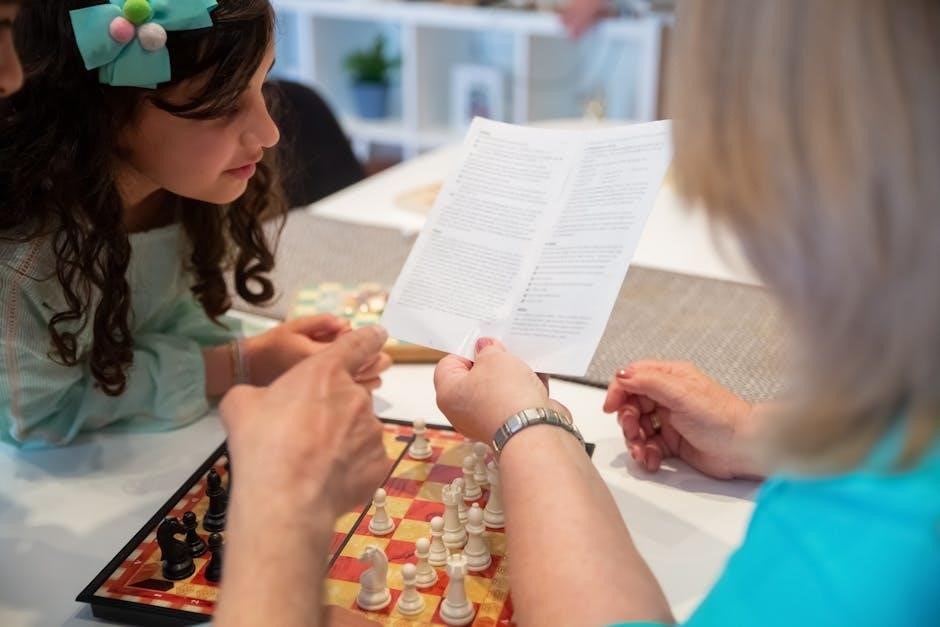Carrom is a popular tabletop game requiring skill and strategy. Understanding its rules is essential for fair play and enjoyment. The Queen’s central placement and carrom-men arrangement are crucial. Official guidelines from the International Carrom Federation ensure consistency. Mastering these rules enhances gameplay and competitive spirit.
Overview of Carrom and Its Popularity
Carrom is a tabletop game of Indian origin, widely popular in South Asia and gaining global recognition. Its simplicity and accessibility make it a favorite in both casual and competitive settings. Played with a striker and carrom-men, the game requires precision and skill. Carrom is enjoyed across age groups, fostering social interaction and healthy competition. Its popularity has grown through organized tournaments and the rise of official rulebooks, making it a beloved pastime worldwide.
Importance of Understanding the Rules
Understanding carrom rules ensures fair play and enhances enjoyment for all players. It clarifies game mechanics, penalties, and winning conditions, preventing disputes. Proper knowledge of rules fosters a competitive yet respectful environment, allowing players to focus on strategy and skill. Adhering to guidelines ensures consistency, whether in casual games or professional tournaments. The official rules, detailed in PDF guides, cover setup, gameplay, and fouls, providing a comprehensive framework for players of all levels. Mastery of these rules is essential for maximizing the game’s potential and enjoying it to the fullest.

Carrom Board Setup and Equipment
The Carrom board setup includes arranging carrom-men around the Queen, with the striker placed at the baseline. Essential equipment like the board, striker, and carrom-men ensure smooth gameplay.
Dimensions and Specifications of the Carrom Board
The Carrom board must be made of smooth plywood or equivalent wood, measuring between 73.50 cm and 74 cm square. Its thickness should not be less than 8 mm. The playing surface must be completely smooth to ensure consistent gameplay. According to the International Carrom Federation, these dimensions are non-negotiable for official matches. Proper board specifications are critical for fair play and maintaining the game’s integrity. Players can refer to the official Carrom rules PDF for detailed measurements and material requirements.
The Playing Surface and Required Quality
The playing surface of a Carrom board must be made of plywood or equally smooth wood, ensuring consistent gameplay. It should be free from imperfections and have a polished finish. The surface must be between 73.50 cm and 74 cm square, with a thickness of at least 8 mm. Smoothness is crucial for the carrom-men to glide effortlessly. Official rules, as detailed in the Carrom rules PDF, emphasize that the board’s quality directly impacts performance. A high-quality surface ensures fair play and enhances the gaming experience for all players.
Pockets and Their Placement on the Board
The Carrom board features four pockets, one at each corner, designed to allow carrom-men and the striker to be pocketed. These pockets are typically made of netting or metal and are slightly raised to prevent the striker from entering. The placement of the pockets is standardized, ensuring symmetry and fair play. According to the Carrom rules PDF, the pockets must be securely attached to the board and free from obstructions. Their size and depth are critical, as they determine the difficulty of pocketing pieces. Proper pocket placement is essential for maintaining the integrity and balance of the game, ensuring a consistent experience for all players.
Initial Arrangement of Carrom-Men and the Queen
The game begins with the Queen placed at the center of the board. Around it, six carrom-men are arranged in a circle, each touching the Queen and their adjacent pieces. These form the inner circle. The remaining twelve carrom-men are positioned around this inner circle, creating an outer ring. Each outer piece must touch the inner circle, ensuring proper spacing and symmetry. This setup ensures fair play and maintains the game’s balance. The arrangement is crucial for the game’s progression and is outlined in detail in the Carrom rules PDF for consistency across all matches.

Game Equipment Details
The game requires a Carrom board, striker, carrom-men, Queen, and carrom powder. Each piece has specific roles and specifications, ensuring smooth gameplay and fair competition, as detailed in the Carrom rules PDF.
The Striker and Its Role in the Game
The striker is a larger disc used to hit carrom-men into pockets. Made of wood, it must be circular with a smooth surface. Proper striking technique is crucial for control and accuracy. Sinking the striker incurs penalties, such as losing a turn or a piece. According to the Carrom rules PDF, the striker’s role is central to gameplay, requiring skill to avoid fouls and maximize scoring opportunities. Its size and weight are standardized to ensure fair play across all matches. Mastery of the striker is key to success in Carrom.
Carrom-Men: Types and Specifications
Carrom-men are circular wooden discs used in the game, typically made from high-quality wood. They are standardized in size, with a diameter of 3.5 cm and a thickness of 5 mm. The weight varies slightly between pieces to ensure consistency. Players can easily distinguish carrom-men by their distinct colors and designs. The queen, a red disc, stands out as a special piece with unique rules. All carrom-men must be smooth and free of imperfections to ensure fair gameplay. Proper specifications ensure uniformity, making the game enjoyable and competitive for all players.
The Queen: Its Significance and Placement
The Queen is a red disc in Carrom, symbolizing the highest value and strategic importance. Placed at the board’s center during setup, it is surrounded by six white and black carrom-men arranged in a circle. The Queen must be pocketed and covered by a player to score its 50 points. Once a player pockets the Queen, they must cover it by pocketing one of their carrom-men in the same turn; failure to do so results in a foul. The Queen remains covered until the end of the game, emphasizing its pivotal role in achieving victory.
Carrom Powder: Its Use and Importance
Carrom powder is essential for ensuring smooth gameplay by reducing friction on the board. It is applied evenly across the playing surface before each game to allow the striker and carrom-men to glide effortlessly. This enhances precision and control during strikes. The powder prevents the discs from sticking or skidding unpredictably, maintaining consistent gameplay. Proper application is crucial, as excessive powder can lead to fouls or unfair play. Regular use of high-quality carrom powder is recommended to uphold the game’s integrity and performance standards, as outlined in official carrom rules and guidelines.

Basic Gameplay Rules
Carrom involves pocketing carrom-men using a striker. Players take turns, aiming to score points by potting pieces into corner pockets. The Queen must be covered to count. Precision and strategy are key to outscoring opponents and winning the game.
Objective of the Game: Pocketing Carrom-Men
The primary goal in carrom is to pocket all your carrom-men and the Queen before your opponent. Players use the striker to hit the carrom-men into any of the four corner pockets. The Queen, placed at the center initially, must be pocketed after covering it with a carrom-man. Each pocketed carrom-man scores points, and the player with the highest score wins. If the striker is sunk, penalties apply, and the opponent gains an advantage. Pocketing the Queen without covering it results in a foul, returning the Queen to the board. Precision and strategy are essential to master this skill-based game.
Player Positions and Turns
Players sit opposite each other, with opponents facing one another. The game begins with the player who wins the coin toss or breaks first. Turns alternate between players, allowing each to strike once per turn. If a player pockets a carrom-man, they continue their turn. The Queen must be covered and pocketed legally to count. Fouls, such as sinking the striker, result in penalties and loss of turn. Teams or individual players must adhere to the sequence, ensuring fair play. Proper positioning and adherence to turn order are vital for maintaining game flow and sportsmanship.
Scoring System and Winning Conditions
The scoring system in carrom is based on pocketing carrom-men and the Queen. Each carrom-man is worth points, with the Queen valued at 50 points if legally covered. A player must pocket all their pieces and the Queen to win. The game is typically played to 25 points or 8 boards, whichever comes first. No extra points are awarded for the Queen once a player reaches 22 points. The winner is declared when a player achieves the required points or completes the board, ensuring a fair and competitive conclusion to the match.
Number of Players and Team Arrangements
Carrom is typically played with 2 to 4 players, who can compete individually or in teams. In team play, partners sit alternately, ensuring coordination and strategy. Matches often involve two players facing each other, while four-player games are divided into two teams of two. Teams must adhere to timing rules and be present at the scheduled time. The game accommodates both singles and doubles formats, offering flexibility for different group sizes. Players take turns striking, with opponents sitting opposite each other to ensure fair play and equal opportunities to score. This setup promotes collaboration in teams and healthy competition among individuals.

Miscellaneous Rules
Miscellaneous rules in carrom include penalties for sinking the striker, queen pocketing implications, and fouls. These rules ensure fair play and maintain game integrity and scoring.
Sinking the Striker: Penalties and Consequences

Sinking the striker results in penalties and loss of turn. A penalty piece is placed on the board, and the player’s turn ends. If a carrom-man is pocketed in the same shot, the penalty is reduced, and the player gets another chance. This rule ensures fair play and strategic striking. Proper adherence to these penalties maintains game balance and encourages precise shots.
Queen Pocketing and Its Implications
The Queen, placed at the center, is a critical piece in Carrom. Pocketing the Queen is allowed only if a player has already pocketed a carrom-man in the same turn. Once the Queen is pocketed, it must be covered by pocketing a carrom-man in subsequent turns. If a player fails to cover the Queen, it is returned to the center. The Queen is worth three points but cannot be counted toward the final score until it is legally covered. This rule ensures strategic play and adds complexity to the game, making it essential to plan moves carefully.
Reduction of Penalty for Fouls
Fouls in Carrom can result in penalties, but there are ways to reduce their impact. If a player commits a foul, such as sinking the striker, they lose their turn and may incur additional penalties. However, if a carrom-man is pocketed in the same shot, the penalty is mitigated, and the player retains their turn. Understanding these rules is crucial for strategic play. Proper positioning and legal moves can minimize penalties, ensuring a smoother game. Adherence to rules not only reduces fouls but also enhances the overall gameplay experience, making it fair and enjoyable for all players involved in the match.

Penalties and Fouls
Penalties in Carrom occur for fouls like sinking the striker or touching the board illegally. These result in losing turns or pieces, ensuring fair and competitive play.
Common Penalties and Their Enforcement
Common penalties in Carrom include losing a turn or pieces for fouls like sinking the striker or illegal shots. If a player sinks the striker, they lose one carrom-man and their turn. However, if a carrom-man is pocketed in the same shot, two pieces are returned, and the player retains their turn. Other fouls, such as touching the board or moving a piece illegally, result in a loss of turn. These penalties ensure fair play and adherence to the rules, maintaining the integrity of the game. Enforcement of these rules is crucial for a balanced and competitive experience.
Loss of Turn and Additional Penalties
A player loses their turn for fouls like illegal strikes or touching the board. Additional penalties may apply if multiple rules are violated. For instance, sinking the striker without pocketing a carrom-man results in a loss of turn and a penalty piece. Repeated fouls can lead to further consequences, ensuring fair play. These rules maintain game integrity and encourage strategic play. Penalties are enforced to uphold the game’s standards and ensure all players adhere to the same guidelines, fostering a competitive yet respectful environment. Understanding these penalties is key to mastering Carrom effectively.

Game Progression
The game progresses as players aim to reach 25 points or complete eight boards. Pocketing all carrom-men and the Queen secures victory. Sinking the striker incurs penalties, extending gameplay.
Winning the Game: Points and Board Completion
A match concludes when a player reaches 25 points or completes eight boards. Pocketing all carrom-men and the Queen secures victory. Points for the Queen are capped at 22. Penalties, such as losing a turn or a carrom-man, apply if the striker is sunk without pocketing a piece. Adhering to these rules ensures fair and competitive gameplay.
End of the Game and Final Scoring
The game concludes when a player reaches 25 points or completes eight boards. Final scoring tallies all points, including those from pocketed carrom-men and the Queen. If the striker is sunk without pocketing a piece, penalties apply, deducting points. The Queen’s points are capped at 22. The player with the highest score at the end wins. Proper adherence to rules ensures a fair and conclusive finish to the match.
Concluding the Match and Declaring the Winner
The match ends when a player reaches 25 points or completes eight boards, whichever comes first. The winner is the player with the highest score after all boards are played. If scores are tied, additional boards are played until a winner emerges. The Queen’s points are capped at 22 to ensure fair play. Penalties for fouls are deducted from the final score. The winner is declared once all points are tallied and penalties applied, ensuring a clear and fair conclusion to the game.

Advanced Techniques and Strategies
Mastering advanced techniques and strategies in carrom involves precise striker control, effective positioning, and strategic angle play to outmaneuver opponents and minimize fouls.
Mastering the Art of Striking
Mastering the art of striking is crucial in carrom, requiring precision and control. The striker must be aimed accurately to hit carrom-men effectively. Proper grip, wrist movement, and follow-through ensure consistent shots. Angle play is vital for targeting specific pieces. Players must avoid sinking the striker, as it results in penalties. Practice is key to developing muscle memory and improving accuracy. Advanced techniques include spinning the striker for better control and using English to redirect carrom-men; Consistency in striking leads to higher scores and a competitive edge in the game.
Positioning and Angle Play in Carrom
Positioning and angle play are critical in carrom, as they determine the trajectory of the striker and carrom-men. Accurate angle calculation ensures pieces reach their target pockets. Players must strategically position the striker to maximize control over rebounds and deflections. Mastering different angles allows for precise shots, especially when targeting clusters or the queen. Spin and English can be applied to the striker to manipulate its movement. Proper positioning also minimizes the risk of fouls, such as sinking the striker. Effective angle play enhances scoring opportunities and demonstrates a player’s skill level. It is a key aspect of advanced carrom techniques.

Official Rules and Resources
Official carrom rules are governed by the International Carrom Federation (ICF), ensuring standardized gameplay worldwide. Detailed rulebooks and guides are available online, offering insights into equipment specifications, scoring systems, and penalties. These resources are essential for players seeking to understand and master the game. They provide comprehensive instructions for both beginners and advanced players, ensuring clarity and consistency in carrom gameplay. Accessing these official resources is crucial for competitive play and adherence to global standards.
International Carrom Federation (ICF) Rules
The International Carrom Federation (ICF) establishes standardized rules for carrom, ensuring consistency globally. The ICF rules cover board specifications, striker dimensions, and carrom-men requirements. They outline game procedures, including setup, turns, and scoring systems. Penalties for fouls, such as sinking the striker, are clearly defined. The ICF also provides guidelines for competitive play, including match formats and tournament conduct. These rules are detailed in downloadable PDF guides, making them accessible to players worldwide. Adherence to ICF rules is essential for fair and structured gameplay, whether in casual or professional settings. They promote uniformity and excellence in the sport.
Downloadable PDF Guides and Rulebooks
Official carrom rules are available in downloadable PDF guides, providing comprehensive details on gameplay, equipment, and scoring. These resources, often published by the International Carrom Federation, include diagrams and explanations to clarify rules. Players can access techniques, penalties, and tournament formats. The guides are essential for both beginners and experienced players, ensuring a uniform understanding of the game. They also cover miscellaneous rules, such as striker penalties and queen pocketing. These PDFs are widely available online, making it easy to learn and master carrom rules. They serve as invaluable tools for improving skills and adhering to official standards.
Additional Resources for Learning Carrom
Beyond PDF guides, various online resources offer tutorials, videos, and forums to learn carrom. Websites and communities share tips on techniques, strategies, and rule interpretations. Mobile apps provide interactive lessons, while YouTube channels demonstrate expert plays. Books and e-books delve into advanced tactics and historical insights. Workshops and webinars hosted by experienced players further enhance learning. These resources cater to all skill levels, helping players refine their game. They complement official rulebooks, offering practical advice and real-world examples to improve gameplay and enjoyment of carrom.

